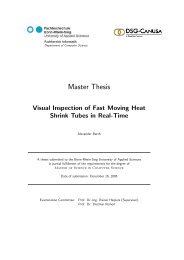Master Thesis - Hochschule Bonn-Rhein-Sieg
Master Thesis - Hochschule Bonn-Rhein-Sieg
Master Thesis - Hochschule Bonn-Rhein-Sieg
Create successful ePaper yourself
Turn your PDF publications into a flip-book with our unique Google optimized e-Paper software.
6. Evaluating the safety <strong>Master</strong> <strong>Thesis</strong> Björn Ostermann page 110 of 126<br />
Frames per Seco<br />
12<br />
10<br />
8<br />
6<br />
4<br />
2<br />
0<br />
Offset: 12 cm<br />
0 2 4 6 8 10 12 14 16<br />
Lines drawn<br />
Median Minimum Maximum<br />
Figure 78: Distance calculation, intrusion at different distances to the robot, offset at 12cm<br />
From those measurements it can be seen that the camera control thread, using the desired offset of<br />
12 cm, works on at least 9 FPS with reachable space computation and decreases to at least 6 FPS with<br />
the calculation of the distance.<br />
Thus the reaction time of the camera control thread is:<br />
- reachable space: 111 ms<br />
- distance calculation: 167 ms<br />
Within those reaction times, the acquisition of a single frame of the camera is already included. This<br />
means that 100 ms of every camera control thread cycle is not used for calculation but is idle time,<br />
waiting on the next image.<br />
The path planning thread proved to be too fast to allow the measuring of a single cycle. Thus it is<br />
assumed at 1 ms.<br />
The robot control thread, communicating with the robot’s PLC, used around 63 ms to complete one<br />
cycle most of the time. At 5 % of the measured cycles it used as much as 78 ms and the worst result<br />
measured was 100 ms. The responses of the PLC to the separate commands were already included in<br />
this time. The thread has to be assumed with its worst result, 100 ms.<br />
When combining all those reaction times, it has to be taken into account that the path planning and the<br />
robot control thread need the results of the previous threads to achieve their task. Because the threads<br />
are not timed, threads can start their computation with old results, just before the previous thread is<br />
finished. Thus, when computing the worst reaction time, the secondary threads have to be counted<br />
twice.














